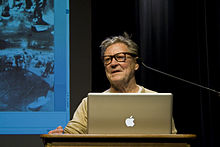Robert Whitman
| Robert Whitman | |
|---|---|
 |
|
| Born | 1935 New York City |
| Nationality | American |
| Education | Rutgers University; Columbia University |
| Notable work | Experiments in Art and Technology |
| Movement | performance art |
Robert Whitman (born 1935 in New York City) is an American artist best known for his seminal theater pieces of the early 1960s combining visual and sound images, actors, film, slides, and evocative props in environments of his own making. Since the late 1960s he has worked with new technologies, and his most recent work incorporates cellphones.
Whitman studied literature at Rutgers University from 1953 to 1957 and art history at Columbia University in 1958. He is represented by The Pace Gallery in New York.
He was a member of the group of visual artists - Allan Kaprow, Red Grooms, Jim Dine, and Claes Oldenburg - who in the early 1960s presented theater pieces on the Lower East Side in Manhattan. Whitman has presented more than 40 theater pieces in the United States and abroad, including American Moon, E.G. and Mouth at the Rueben Gallery. Night Time Sky was his contribution to the First New York Theater Rally in New York in 1965; Prune Flat was first presented at the Cinematheque in New York in 1965 and has been performed numerous times since.
In 1966, Whitman was one of the 10 New York artists who worked with Billy Klüver and more than 30 engineers and scientists from Bell Telephone Laboratories to create works that incorporated new technology for 9 Evenings: Theatre & Engineering, a series of performance artworks presented October 13–23 in 1966 at the 69th Regiment Armory in New York City. For this piece, Two Holes of Water- 3, Whitman used seven automobiles on the floor of the Armory, from which were projected film, over-the-air television programs, and closed-circuit television projections of live performances and actions, including images from one of the first fiber-optic miniature video cameras.
...
Wikipedia
